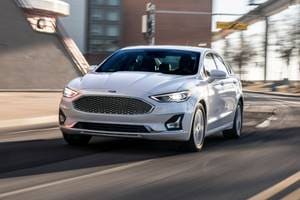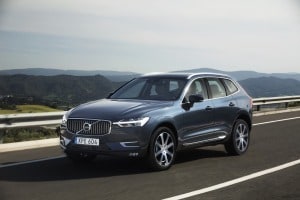The Future Is Now: High-Tech Innovations Drive Automobiles Into the 21st Century
FOR IMMEDIATE RELEASE
The Future Is Now: High-Tech Innovations Drive Automobiles Into the 21st Century
Imagine cruising the highway in an alternatively-fueled Sport Utility Vehicle, getting 60 miles to the gallon, listening to commercial-free satellite radio, all the while navigating your way with the latest in voice-activated GPS technology.
You get a flat tire and, with the touch of a button on your console, immediately send a signal that pinpoints your exact location to an emergency roadside assistance operator.
Sound unreal? Several automobile manufacturers are already hard at work to make this dream a reality.
"Advancements in science and technology are driving the future of the automotive industry," says John Clor, Detroit bureau editor for Edmunds.com. "Reaping the benefits of these forward thinking improvements will not only be the consumer but the environment in many cases as well."
According to Edmunds.com, the Internet's pioneer and leader in providing free, third-party automotive information, these are a few of the high tech trends you can expect coming down the road in the next century.
The Green Revolution
General Motors' groundbreaking EV1, the first major market all-electric vehicle, has paved the way for alternatively fueled vehicles. Spurred by new government regulations for cleaner running engines and an inevitable depletion of natural resources, here's a quick look at the newer technologies being considered by auto manufacturers:
Fuel cell
This technology offers an infinitely renewable power source with almost zero pollutants. Originally conceived in 1839, a fuel cell works like a continuous battery in reverse. The fuel cell converts chemical energy into electricity via a simple oxidation process. Most prototypes in development use either hydrogen or methanol to drive the cells. Researchers estimate another 10-20 years before fuel cell- powered cars enter the market.
Hybrid
These vehicles, which are now on sale in the U.S. market (see sidebar for details), use a blend of high tech innovations to produce electronic drive, which in turn is backed by a traditional internal combustion engine for main motive power. Hybrid vehicles offer a practical and affordable way to increase fuel efficiency while at the same time reducing emissions. These vehicles present a viable and logical transition from gasoline dependence to more renewable resources. Here's a look at what a couple of the major auto manufacturers are up to:
| Honda Insight Model type: Coupe | Powered by a three-cylinder, 1.0 liter gasoline engine with an electric motor back up. The car recently received the highest mileage rankings ever by the EPS at 61 mpg in the city and 70 mpg highway. At dealerships now |
| Toyota Prius Model type: Sedan | Powered by a 1.5 liter, DOHC, 16-valve, four-cylinder powerplant with variable valve timing. The gasoline engine supplies the main motive power for the vehicle, assisted at times by the onboard electric motor. U.S. Availability: Summer, 2000 |
| GM Precept Model type: Sedan | Power for the hybrid Precept is supplied to the front wheels by a battery-powered electric traction system. A lightweight, 1.3 liter, 3-cylinder diesel engine with turbocharged compression ignition is mounted in the rear. GM has laid claim that the Precept is capable of getting 80 miles to the gallon. U.S. Availability: 2004 |
| Ford Th!nk | Ford is the only automaker to dedicate an independent brand to a full line of environmentally responsible products, to include battery and fuel cell electric technology.U.S. Availability TBD |
| Mercedes-Benz NECAR 4 | An ongoing program by Mercedes, now it its fourth generation. Powered by hydrogen fuel cells.U.S. Availability TBD |
Additional information on these and other manufacturers' technologies is available by visiting each of their Web sites.
Digital Satellite Radio
Heralded as one of the biggest breakthroughs for radio since the introduction of the FM band, two national service providers, Sirius and XM Radio, will be bringing satellite technology to the car stereo market. The offering will include up to 100 channels of programming, about half of which will be COMMERCIAL-FREE! This option will be available beginning with 2001 model cars. Manufacturers are also considering an adapter for older stereo units that will allow upgrades to the new frequency.
Auto Security
Noisemaking car alarms typically fall on deaf ears. "The next generation in auto security," says Scott Memmer, Technical Editor at Edmunds.com, "is tracking and retrieval. Companies such as Clifford, Alpine and General Motors have improved upon existing technology and greatly increased the odds of retrieving stolen vehicles."
Clifford Electronics' system, called Mobile Trace 1 and available later this year, utilizes GPS technology to locate and track vehicles to within ten meters (40 feet). Alpine's Mobile MaydayTM, already for sale in the U.S., serves as a GPS tracking device for theft recovery and can also aid a driver in distress. The touch of a button connects a stranded driver to a 24-hour On-Guard® Emergency Response Center. GM's OnStar, available as standard equipment on many GM vehicles (and soon to appear on select Toyota models), offers similar features. These services will be available for a monthly usage fee.
"The wealth of options and features available on current and next generation automobiles are creating a more personalized driving experience," says John Clor, Detroit bureau editor for Edmunds.com. "The future of the industry, without a doubt, is an automobile lover's dream."
For more information about automotive innovations, visit the Edmunds' Web site at www.edmunds.com.








